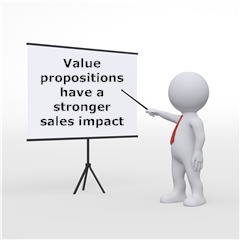Jill Konrath's Blog, page 25
October 30, 2013
Elevator Speech vs. Unique Selling Proposition vs. Value Proposition
 Without a strong value proposition, it’s much harder to sell your products or services in today’s economy, much less even get in the door of big companies. But what is a value proposition? And how is it different from other commonly used terms?
Without a strong value proposition, it’s much harder to sell your products or services in today’s economy, much less even get in the door of big companies. But what is a value proposition? And how is it different from other commonly used terms?
A value proposition is often confused with an “Elevator Speech” or a “Unique Selling Proposition.” It’s essential to understand the difference between these terms because their purposes and sales impact are very different.
Elevator Speech
An elevator speech is a short, 1-2 sentence statement that defines who you work with (target market) and the general area in which you help them.
About 10 seconds long, it’s used primarily at networking events to attract potential clients and stimulate discussion. The following elevator speeches show you how some people describe what they do:
“I work with small businesses who are struggling to sell their products or services into large corporate accounts.”
“We help technology companies effectively use their customer information to drive repeat sales.”
“I help small-to-medium sized manufacturing companies who have difficulties with unpredictable revenue streams.”
Unique Selling Proposition
A unique selling proposition (USP) is a statement about what makes you and your company different from other vendors.
Its primary value is to create competitive differentiation. A USP is often used in marketing materials or in talking with customers who are ready to buy.
Here are a few good USP examples:
We specialize in working with financial institutions. (Specialty)
We guarantee service in 4 hours or your money back. (Guarantee)
We use a unique tool called SureFire! to analyze your critical needs. (Methodology)
Helping customers understand your USP is imperative when they’ve already decided to make a purchase decision. But USPs have absolutely no impact when customers are satisfied with their situation or when they’re frustrated but haven’t yet decided to change. USPs are far more effective in the business-to-consumer market than in business-to-business sales.
Value Proposition
A value proposition is a clear statement of the tangible results a customer gets from using your products or services.
A strong value proposition is specific, often citing numbers or percentages. It may include a quick synopsis of your work with similar customers as a proof source and demonstration of your capability. Here are a couple examples to stimulate your thinking:
“We help large companies reduce the cost of their employee benefits programs without impacting benefit levels. With the spiraling costs of health care today, this is a critical issue for most businesses. One of our recent clients, a large manufacturing company similar to yours, was struggling with how to reduce spending in this area. We saved them over $800,000 in just six months. Plus, they didn’t cut any services to their employees, nor did their employees have to pay more.”
“I help technology companies who are launching an important new product into the marketplace – and need it to be successful to achieve their sales forecast. Where I help my clients is in the often dropped hand-off between marketing and sales. As a result, they’re able to more easily meet projected sales goals and significantly shorten time-to-profitability.”
Both the elevator speech and the USP are cousins of the value proposition, but there is one vital difference: they lack the punch of a value proposition when selling to the corporate market.
To learn more about how to create a strong value proposition, download the Value Proposition Toolkit: Value Proposition Kit






October 28, 2013
[Video] Your Inadvertent Business Jargon May Be Confusing Prospects
Could you possibly be confusing your prospects with business jargon? I’m sure you wouldn’t do it intentionally, but if you don’t pay close attention you might still be doing it.
For example, just the other day I got an email asking me if I’d be interested in speaking at the upcoming IFC Conference. While I was delighted to be considered, I had no idea what IFC stood for. So I googled it. But, then I was even more confused – was it the International Fundraising Congress, the Investing Financing Council, or the Inter-Fraternity Connection?
Turns out it was none of the above. But it did get me thinking about how often we use business words or acronyms and just assume that the people we’re talking to know what we mean. When we do that, it actually creates a rift. They get stuck trying to figure out what we mean and can’t pay attention to what we’re saying. That doesn’t help us at all.
Or, we deliberately use impressive sounding terminology to make our prospects think we’re really smart. Instead, they think we’re pompous you-know-what’s. Or, they feel really dumb. That doesn’t work either.
Our goal should always be to ensure clear communications. That means we need to speak like we’re talking to normal human beings. Sometimes that’s harder than it sounds. But, by keeping things simple, we all benefit.







October 24, 2013
[Video] Dealing With Fear When You're Selling
If you're selling, you're most likely experiencing fear. I say that, because I've dealt with it my entire professional career. I've worried about meeting my quota. Then, when I did, I worried about doing it the next month. I was afraid of losing customers or worse yet, losing opportunities to competitors.
No one really talks about this fear, but it's underneath everything. When you're fearful, you try to push your prospects to make decisions faster. You also sell harder – trying to convince people to buy from you. But those fear-based actions actually boomerang against you – and make it harder to get the business.
The first, and most important step, in dealing with the fear is to recognize it. For me, sometimes it was always a feeling of dread, deep in the pit of my stomach. Other times, it was an anxiety, causing me to have a shortness of breath. Sometimes it was even frenetic behavior.
Once you recognize yourself doing things, it's imperative that you quiet & calm yourself down. You literally need to say to the fear, "I know you're there, but this isn't helping me right now. It just making things worse. I need you to take a break so that I can think clearly." Here's the deal: You can either let your fear win – and then you lose. Or, you can learn how to effectively live with it.







October 19, 2013
Simple Strategy to Turn Lost Sales Into Sales Success
 The other day I was at the Olive Garden talking to a prospective client over lunch. He was telling me about all the challenges his sales organization was facing.
The other day I was at the Olive Garden talking to a prospective client over lunch. He was telling me about all the challenges his sales organization was facing.
Setting up appointments with new prospects was a nightmare. Decisions were taking longer and longer to make. Competition was everywhere, undercutting their proposals.
His reps were frustrated, discouraged.
“If only they could all be like Paula,” he said, shaking his head in frustration. “Can you clone her?
I laughed, but my curiosity was piqued. “Tell me more,” I said.
It seems that Paula was having a really good year, despite everything that was going on. She cracked into a few big accounts that she'd targeted at the beginning of the year. Despite losing some business to competitors, she'd won more than her share without major discounting.
Even the numerous obstacles that seemed to totally derail the other sales reps, only set her back temporarily.
“Let me guess,” I interrupted. “Those setbacks almost seem to energize her. Right?”
My client, who was about to take a bite of fettuccine, set down his fork. Looking at me quizzically, he said almost in a whisper, “How did you know? That's exactly what happens.”
I smiled slowly, but couldn't keep the twinkle out of my eyes. I leaned forward and whispered, “Paula kisses the frogs.”
My client burst out laughing. It certainly wasn't the answer he expected. But, it was the truth.
Over the years I've met other Paulas and they're usually top performers. What differentiates them from other sellers is their approach to the setbacks (or ugly frogs) they invariably encounter in selling.
When faced with tough times, frog kissers like Paula reframe those obstacles into personal challenges. Rather than getting discouraged or blaming others, they ask:
How can I tackle this new situation?
What other options can I try?
What can I learn by kissing this frog
With their creative energies ignited, new options and alternatives emerge. Limitations become possibilities. They experiment with different approaches, willing to grow in the process. As a result, frog kissers are often able to transform their lost sales into successes.
So here's my challenge to you. In the next month you're likely to run into a few sales problems such as disinterested prospects, angry customers, delayed decisions, or cut-throat competitors. This time, instead of getting upset, go kiss the frogs.






October 18, 2013
80% of Sales Jobs Will Change In the Next 3 Years
 It is a fact. Many sales experts are telling us that 80% of sales roles will change by 2016. That doesn't necessarily mean that 8 out of 10 salespeople will lose their jobs. But it does mean that most of us are going to have to change the way we sell.
It is a fact. Many sales experts are telling us that 80% of sales roles will change by 2016. That doesn't necessarily mean that 8 out of 10 salespeople will lose their jobs. But it does mean that most of us are going to have to change the way we sell.
We already know that the way we communicate is changing. The way we learn is changing, as we use the internet to research and keep up to date. And, the way we develop relationships is changing as we connect with people through social media sites like LinkedIn and Twitter.
And of course the way we buy and sell is changing forever. If you'd like to learn fresh strategies that actually work in today's business environment, check out Top Sales World (TSW), a unique site dedicated exclusively to the profession of sales.
TSW draws the industry's best known sales experts (including me) who provide unparalleled advice in the form of how to guides, articles, web-based master classes, roundtables and so much more. It's the world's first online "sales hypermarket" with the shelves stacked with every conceivable resource that front-line sales professionals and their managers could possibly need -- and it's all free.
You will love this short video.
After you have watched it, get yourself over to Top Sales World, and join with thousands of like-minded sales professionals, who are committed to winning – you will not find many losers over there!






80% of sales jobs will change in the next 3 years
 It is a fact. Many sales experts are telling us that 80% of sales roles will change by 2016. That doesn't necessarily mean that 8 out of 10 salespeople will lose their jobs. But it does mean that most of us are going to have to change the way we sell.
It is a fact. Many sales experts are telling us that 80% of sales roles will change by 2016. That doesn't necessarily mean that 8 out of 10 salespeople will lose their jobs. But it does mean that most of us are going to have to change the way we sell.
We already know that the way we communicate is changing. The way we learn is changing, as we use the internet to research and keep up to date. And, the way we develop relationships is changing as we connect with people through social media sites like LinkedIn and Twitter.
And of course the way we buy and sell is changing forever. If you'd like to learn fresh strategies that actually work in today's business environment, check out Top Sales World (TSW), a unique site dedicated exclusively to the profession of sales.
TSW draws the industry's best known sales experts (including me) who provide unparalleled advice in the form of how to guides, articles, web-based master classes, roundtables and so much more. It's the world's first online "sales hypermarket" with the shelves stacked with every conceivable resource that front-line sales professionals and their managers could possibly need -- and it's all free.
You will love this short video.
After you have watched it, get yourself over to Top Sales World, and join with thousands of like-minded sales professionals, who are committed to winning – you will not find many losers over there!






October 16, 2013
[Video] The Only Sales Letter You'll Ever Need to Write
If you're like most sellers, you want to create the perfect message -- one that your prospects will read and immediately pick up the phone to invite you into their offices.
You agonize over what to include in it. You struggle to find just the right words to showcase your expertise without sounding like you're a braggart. You wonder just how much you should include about your company, products and services. And sometimes, you even write to me for advice!
Here's the deal. You need to get over it. There is no perfect sales letter. It's virtually impossible to craft just one message that is guaranteed to get results. People are busy. On a bad day, they'll delete or throw out even the best message. Plus, different decision makers care about different things,
So, instead of fretting about perfection, focus on crafting a series of messages that you'll send out over time. Research is showing that it's taking between 8-14 contacts to actually have a conversation with a human being.
Knowing that should free you from trying to craft the perfect message. Spread your value proposition over multiple emails, voice mails and sales letters. Stress just one point in each.
That's what it takes to set up meetings today. I can't sprinkle any fairy dust on you to give you different results. You just need to do the work!







October 14, 2013
[Video] 4 Critical Questions to Outsmart Your Sales Competition
What if you were at risk of losing your best customer?
It’s time to get your thinking cap out again. I’m here to stretch you out of your comfort zone so you can see things in new ways. Today we’re going to look at your very best customer – the one you love working with and who contributes a fair share to your income. Got it?
Good, because now I want you to put yourself in your competitor’s shoes. You want this account really badly. And you know whose currently got the business.
So as you sit now, in your competitor’s shoes, here’s some questions I want you to think about:
Four critical questions to stop your sales competition from stealing your best customers (or to unseat an incumbent!)
Do you see any weaknesses that you could potentially exploit?
Are there any industry or market trends that could create an opening?
Is the incumbent addressing all their needs – or just some? Would that be a way in?
How the company changing? Do they need help in new areas?
Those are just four questions to ponder. But do you see where I’m going with this? By looking at your best account from your competitor’s perspective you can do two things:
Find out where you’re vulnerable so you can prevent it from happening.
Identify areas where you can create new sales opportunities.
So take some time today and think about it. What you discover can make a big difference.







October 9, 2013
Leveraging LinkedIn Connections
Connections matter. Big time. Recent research from Reachable.com shows just how much it impacts you're ability to get a callback from a "stranger." In fact, you're:
3x more likely if you contact a mutual acquaintance.
4x more likely if the connection calls to make an introduction.
11x more likely if they have an actual connection.
See. It does make a difference. But most sellers don't know how to leverage their LinkedIn connections nearly as much as they could.

To help you expand your thinking, here are some TRUE STORIES shared by people who took our 2013 Sales & LinkedIn Survey. By reading them, you'll discover numerous ways you can get in touch with someone even if you don't have a 1st level connection.
Connecting to CEOs. I always look to see if and how I am connected to a prospect. If I find a common connection, I’ll normally speak with him/her first to find out how they’re connected, what the experience was like and whether I can use their name. By doing this, I've landed a number of meetings with CEOs at target companies. ~ Ralph O.
When Your Prospects Aren't on LinkedIn. "I work with seniors, but I am referred by business partners such as attorneys, financial planners, certified financial planners and insurance planners. Senior workers are good targets, but getting to my senior customers through LinkedIn is almost impossible. I need to get to the people who can refer to me." ~ Bernadette C.
Leveraging 2nd-Level Connections. "There was an organization that I was trying to penetrate. As I looked through the list of active LinkedIn users, I wrote down the names of my 2nd level connections. Then I looked at each of their profiles to find out who my 1st level connection was to these individuals. One was connected to a close friend of mine. As I looked over her bio, I noticed she and my friend had worked together before. When I connected with this 2nd level person via email, I mentioned our mutual friend. She then got me in contact with the right person within her organization." ~ Bryan K.
Alumni Groups Deliver. "I've utilized my college Alumni Group to InMail fellow alums (who I don't know) to identify my contact within their organization. Every one of them has been willing to help a fellow alumni out." ~ Rob H.
Leveraging Centers of Influence. "I take my best COI (center of influence) clients and look at their connections to see who they can introduce me to. Then I ask my clients if they would do an introduction to Mr. X by putting in a good word for my services. That way, when I call Mr. X, they are already eager to talk with me." ~ Tom B.
Who’s Looking at You. "I saw that someone from a company I’d been trying to get into had viewed my profile. It wasn't the purchasing agent I'd been trying to speak with, but her boss. I used that as my 'in' and contacted him directly. After that, I got the meeting I wanted and it ended with a good order. I'm still working on more follow-up business, but am now an established supplier there." ~ Jay O.
One Thing Leads to Another. "I connected with someone who was interested in using me for a project he was working on. It gave me a chance to get to know him and have several conversations during which I was able to demonstrate my expertise. While that project never came about, he did introduce me to his subsequent employer for some input on another related project. After an in-person meeting, I received a consulting agreement, which later turned into a two year gig. There is no possible way I would have ever met any of these people without LinkedIn." ~ Larry W.
Old Contact Re-emerges. An old contact (SVP level) popped on the "list of people you may know." I’d lost touch with him because he’d semi-retired. I reached out to him again to connect via Linkedin. One week later, my cell phone went off. I answered it and it was my old contact. He needed help with a sales team he was now leading. This led to a new engagement for me. He then proceeded to introduce me to other division heads in his business. We continue to have a business relationship three years later." ~ Don G.
Old Friend Opens Door. "I re-connected with a friend from my High School, whom I lost touch with during the past 30 years. After the initial invite and connection via LinkedIn, we spoke on the phone. He asked me what I'm doing and I told him about my business and a new on-line shipping tool. He immediately gave me a key contact for a company that he is an investor with. This opened a door to meet with this contact and start doing business managing their transportation." ~Dave M.
So what do you think? Any chance you can leverage your LinkedIn connections better after seeing how your colleagues are doing it? I sure hope so!






October 7, 2013
[Video] The Two Words That Matter Most in Sales
I was reading a non-sales related blog post the other day when suddenly I came to a screeching halt. Two words jumped out at me. And, I immediately thought – these words capture exactly what it takes to be successful in sales today.
Relentlessly Useful.
If we want to get our foot in the door of new companies and earn their business, we need to be relentlessly useful.
If we want to grow our existing customers, we need to be relentlessly useful.
If we want to prevent competitive inroads into our best accounts, we need to be relentlessly useful.
We have to proactively and continuously bring our customers ideas, insights and information that helps them achieve their goals. If we do, they’ll buy our products and services because of what we bring them – and because of who we are.
Think about it. What do you need to do to become relentlessly useful?







Jill Konrath's Blog
- Jill Konrath's profile
- 28 followers



